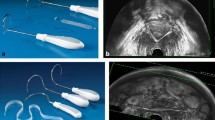Abstract
Purpose
The aim of this study was to assess the association between four-dimensional translabial ultrasound (4D-TLUS) features of the retropubic mid-urethral sling (MUS) and post-operative pelvic floor symptoms.
Methods
A prospective cohort study was performed involving 100 women who had a solitary retropubic MUS (TVT Exact™) between Jan 2013 and Dec 2017 for urodynamic stress incontinence (SI) at a tertiary urogynaecological centre. All patients completed a standardised interview and had free flowmetry, prolapse evaluation and assessment for mesh exposure and tenderness. 4D-TLUS parameters measured included pelvic organ descent, levator ani status, sling–symphysis pubis (SP) gap at rest and Valsalva, angle formed by cranial and caudal ends of the sling, cranio-caudal and dorso-ventral sling–symphysis pubis distance at Valsalva. The primary outcome was treatment success as defined by patient report of cure or improvement and no objective demonstrable SI.
Results
Eighty-nine (89%) patients reported treatment success. Two patients (2%) had mesh exposure; one was symptomatic with pain, requiring complete sling removal. There was a significant association between treatment success and a SP gap at Valsalva of 10–12 mm (p = 0.001); and independently with a SP angle at Valsalva of 45°–80° (p = 0.007). A narrower SP gap at Valsalva closer to 10 mm was associated with voiding symptoms (p = 0.036).
Conclusion
Sling–pubis gap and sling–pubis angle at Valsalva appear to be significantly associated with treatment success in retropubic MUS. There is a significant association between a narrower sling–pubis gap at Valsalva and voiding symptoms.


Similar content being viewed by others
References
Ogah J, Cody JD, Rogerson L (2009) Minimally invasive synthetic suburethral sling operations for stress urinary incontinence in women. Cochrane Database Syst Rev
Lapitan MCM, Cody JD, Mashayeki A (2017) Open retropubic colposuspension for urinary incontinence in women. Cochrane Database Syst Rev 2017(7): Art No CD002912
Ford AA, Rogerson L, Cody JD, Aluko P, Ogah JA (2017) Mid-urethral sling operations for stress urinary incontinence in women. Cochrane Database Syst Rev 2017(7): Art. No.: CD006375. doi: https://doi.org/10.1002/14651858.CD006375.pub4.
Opinion of the Safety of Surgical Meshes Used in Urogynecological Surgery (2015) The European Commission: Scientific Committee in Emerging and Newly Identified Health Risks 3
Urinary Incontinence in Women: Management (2015) NICE guidance
Nilsson CG, Palva K, Aarnio R, Morcos E, Falconer C (2013) Seventeen years’ follow-up of the tension-free vaginal tape procedure for female stress urinary incontinence. IUJ 24(8):1265–1269
Dietz HP, Wilson PD (2004) The ‘iris’ effect: how two-dimensional and three-dimensional ultrasound can help us understand anti-incontinence procedures. Ultrasound Obstet Gynecol 23:267–271
Chantarasorn V, Shek KL, Dietz HP (2011) Sonographic appearance of transobturator slings: implications for function and dysfunction. Int Urogynecol J Pelvic Floor Dysfunct 22:493–498
Yang JM, Yang SH, Huang WC (2009) Correlation of morphological alterations and functional impairment of the tension-free vaginal tape obturator procedure. J Urol 181:211–218
Masata J, Martan A, Svabik K, Drahoradova P, Pavlikova M (2006) Ultrasound imaging of the lower urinary tract after successful tension-free vaginal tape (TVT) procedure. Ultrasound Obstet Gynecol 28:221–228
Chene G, Cotte B, Tardieu AS, Savary D, Mansoor A (2008) Clinical and ultrasonographic correlations following three surgical anti-incontinence procedures (TOT, TVT and TVT-O). Int Urogynecol J Pelvic Floor Dysfunct 19:1125–1131
Foulot H, Uzan I, Chopin N, Borghese B, Chapron C (2007) Monarc transobturator sling system for the treatment of female urinary stress incontinence: results of a post-operative transvaginal ultrasonography. Int Urogynecol J Pelvic Floor Dysfunct 18:857–861
Kociszewski J, Rautenberg O, Kolben S, Eberhard J, Hilgers R, Viereck V (2010) Tape functionality: position, change in shape, and outcome after TVT procedure—mid-term results. Int Urogynecol J Pelvic Floor Dysfunct 21:795–800
Yang JM, Yang SH, Huang WC, Tzeng CR (2012) Correlation of tape location and tension with surgical outcome after transobturator suburethral tape procedures. Ultrasound Obstet Gynecol 39:458–465
Lo TS, Wang AC, Horng SG, Liang CC, Soong YK (2001) Ultrasonographic and urodynamic evaluation after tension free vagina tape procedure (TVT). Acta Obstet Gynecol Scand 80:65–70
Haylen BT, Maher CF, Barber MT et al (2016) An International Urogynecological Association (IUGA)/International Continence Society (ICS) joint report on the terminology for female pelvic organ prolapse (POP). Int Urogynecol J 27(2):165–194
Haylen BT, De Ridder D, Freeman RM et al (2010) An International Urogynecological Association (IUGA)/International Continence Society (ICS) joint report on the terminology for female pelvic floor dysfunction. Neurourol Urodyn 29:4–20
Shek KL, Dietz HP (2016) Assessment of pelvic organ prolapse: a review. Ultrasound Obstet Gynecol 48:681–692
Dietz H, Haylen B, Broome J (2001) Ultrasound in the quantification of female pelvic organ prolapse. Ultrasound Obstet Gynecol 18(5):511–514
Shek KL, Dietz HP (2015) What is abnormal uterine descent on translabial ultrasound? Int Urogynecol J 26(12):1783–1787
Dietz HP, Steensma AB (2005) Posterior compartment prolapse on two-dimensional and three-dimensional pelvic floor ultrasound: the distinction between true rectocele, perineal hypermobility and enterocele. Ultrasound Obstet Gynecol 26(1):73–77
Acknowledgements
Urogynaecology nurses and administration staff for helping with appointments.
Author information
Authors and Affiliations
Contributions
YHT: Protocol/project development, data collection, management and analysis, manuscript writing. MF: Manuscript editing. IH: Assistance with statistical analysis, manuscript editing. VW: Protocol/project development, manuscript editing.
Corresponding author
Ethics declarations
Conflict of interest
Frazer: Past paid preceptor for Ethicon (till 2011); No conflicts: Tan/Hughes/Wong.
Additional information
Publisher's Note
Springer Nature remains neutral with regard to jurisdictional claims in published maps and institutional affiliations.
Electronic supplementary material
Below is the link to the electronic supplementary material.
Rights and permissions
About this article
Cite this article
Tan, Y.H., Frazer, M.I., Hughes, I. et al. Correlation between translabial ultrasound parameters and outcomes in retropubic mid-urethral slings: can we predict success?. World J Urol 39, 163–168 (2021). https://doi.org/10.1007/s00345-020-03153-8
Received:
Accepted:
Published:
Issue Date:
DOI: https://doi.org/10.1007/s00345-020-03153-8




